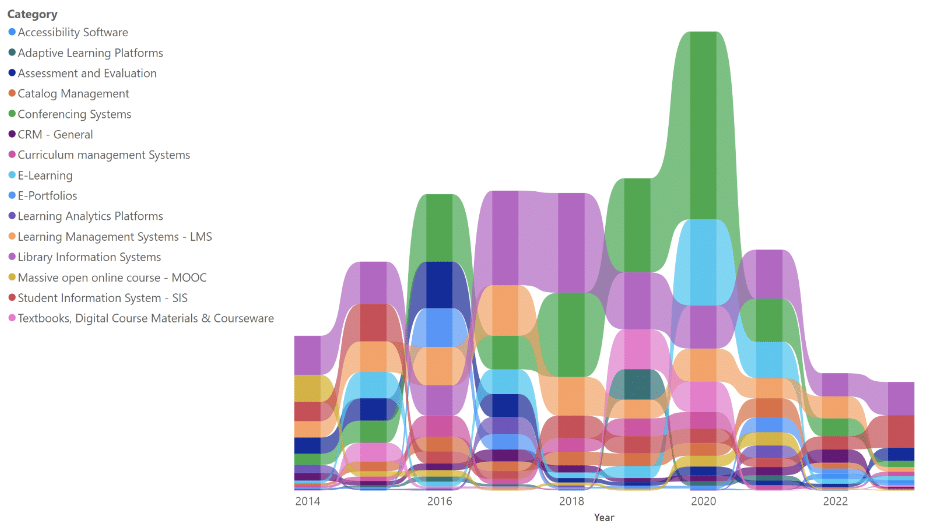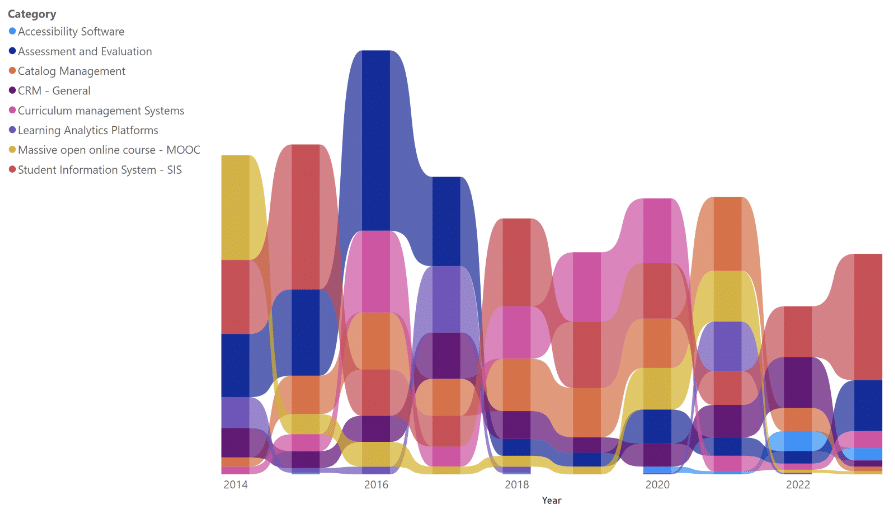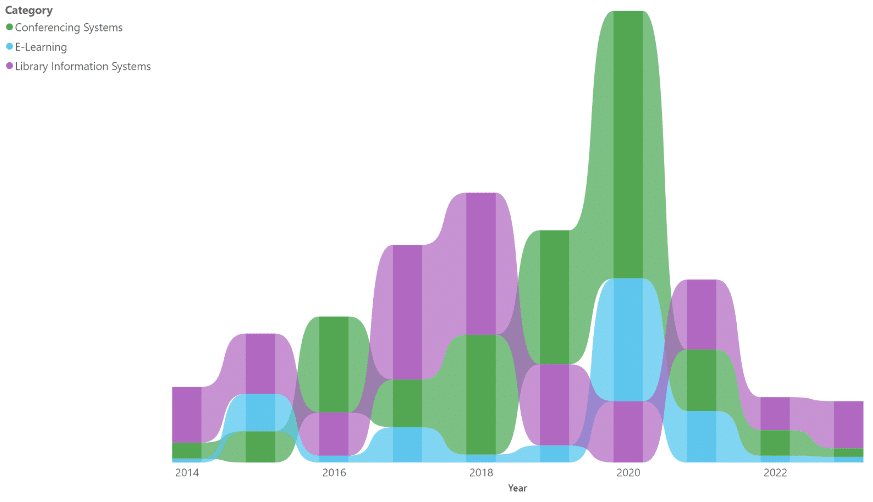
A recent article in Inside Higher Ed shed light on the challenges institutional leaders at two-year institutions face in adopting technology, specifically technology that supports online learning. The authors discuss how these leaders try to overcome financial constraints, staffing issues, and procurement issues to meet the increased demand for quality online learning at their institutions.
The insights provided by the article led us to ask two questions: how have community college leaders adopted and bundled their technologies to provide teaching and learning overall and online learning? Likewise, might we see patterns in these adoptions and bundles over time that might give us a view into how these leaders have changed their approach to meet increased student demand?
Methodology
To better understand these trends, we analyzed data for about 3,700 two-year institutions – public and private – to determine net-new implementations for technology implementations within the teaching and learning ecosystem and those, like the student information system, that support the ecosystem. We then used a time series clustering approach, which organizes trend data points over time into groups based on their similarities. This approach has two goals:
- Identify implementation patterns: Gaining insight into whether groups of trends historically move upward, downward, or horizontally together over time.
- Predict and recommend next steps: Understanding these clusters can help predict the future, like understanding past wind patterns can predict today’s wind patterns.
For example, Figure 1 looks at the overall implementation trends for these technologies over the past ten years and their relative rankings.

In isolation, this aggregate view might lead us to believe that all technologies rose and fell similarly since 2014, with the most significant spike in overall implementations occurring in 2020. Likewise, this figure suggests community college leaders have looked to adopt more conferencing systems and library information systems than other technologies. Yet, further analysis of implementation trends suggests more to the story.

Findings
Applying our time series clustering approach to implementation trend data shows that not all institutional technology acquisitions followed the above pattern. For example, Figure 2 shows the implementation patterns of a specific technology bundle that primarily provides or supports a teaching and learning ecosystem’s core functions, such as assessment management, curriculum management, or catalog management. These segments include Assessment and Evaluation Solutions, Curriculum Management Solutions, Catalog Management Solutions, and Student Information Systems. We’ve described the technology strategy of these institutions as “Focusing on Infrastructure.”

Likewise, you should note that institutions in Cluster 1 do not mirror the overall pattern in Figure 1, with a spike in implementations occurring in 2016 and not 2020. The data indicates that instead of focusing on acquiring solutions to enable course delivery, like Zoom, leaders at these institutions decided to strengthen their teaching and learning infrastructures during the pandemic. These institutions also bucked the overall trend of acquiring significantly more technology during the pandemic; the spike in acquisitions is lower than in previous years.
Figure 3 provides another example of the dangers of assuming that the overall implementation pattern is valid for all technologies and institutions. We characterize the technology strategy of Cluster 2 institutions as “Ensuring Effective Course Delivery.” The implementations of this cluster consist of bundles of solutions that mainly help institutions support the ways institutions might deliver teaching and learning. This cluster comprises Adaptive Learning Solutions, E-Portfolio Solutions, Learning Management Systems, and Textbook, Digital Course Materials and Courseware Solutions.

Like the first cluster, trends in Cluster 2 do not mirror the overall pattern, with a spike in implementations occurring in 2019 and not 2020. The data suggests that, unlike the general trends and trends in the previous cluster, these schools concentrated more on implementing tools that helped deliver courses and course materials. Also, we saw in the last cluster that these leaders also acquired less technology during the height of the pandemic than in some previous years.
Figure 4 shows the final cluster. This cluster, which we call “Responding to Remote Learning,” consists of technologies that help institutions focus on ensuring that they can deliver learning in a remote environment, thereby ensuring that students can access content and that faculty can assess their understanding of that content., This cluster tracks the overall trends, with the most significant number of implementations occurring in 2020, and comprises solutions such as Conferencing Systems and E-Learning Solutions. Likewise, leaders of institutions in this cluster implemented more library information systems than leaders in other clusters, suggesting that they see these systems as key in managing digital materials.

Why do these clusters matter? First, these clusters give us more insight into the interrelationship between implementation trends within two-year institutions. Rather than looking only at an individual segment’s upward or downward movement, we now see segments showing similar implementation patterns over time.
This approach also helps us become more efficient in our predictions as the longitudinal correlation of products guides us to consider whether and how institutions group products. As a result, when predicting a segment’s future market share increase, like the LMS, we might consider the consequent increase in the market share of another product in the same cluster, such as Textbook, Digital Course Materials and Courseware Solutions.
Summary
This type of analysis reveals the interrelationships of technology implementation trends over time. But what do they predict about the future of how two-year colleges might meet student demand for online learning?
In our conversations with institutional leaders, they increasingly view technologies as groups to support different problem domains, such as online learning. Many vendors we talk to are also closely considering how their products fit within groups, whether they provide many components, as Anthology and Ellucian do, or just one, like Zoom or Learning Technologies Group, etc., which can address problem domains together.
Therefore, we predict that technologies at two-year colleges will show significant tectonic shifts as leaders continue to determine which bundles best support online learning. Also, we recommend that institutions and vendors place greater focus on and demand for interoperability of products within clusters to meet the requirement that products within clusters work together.

